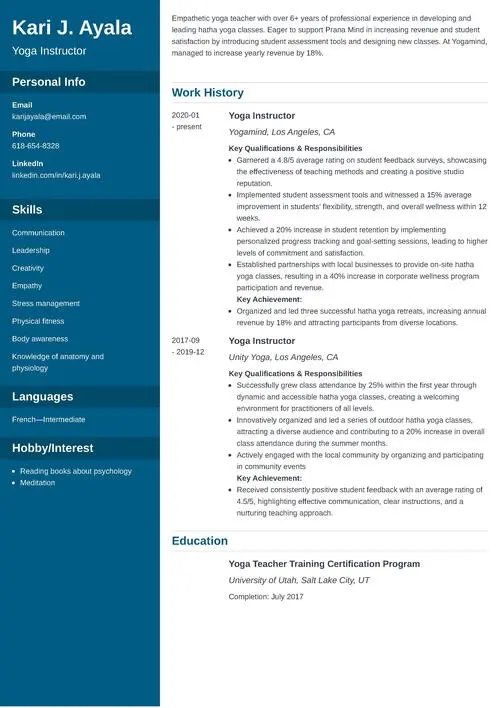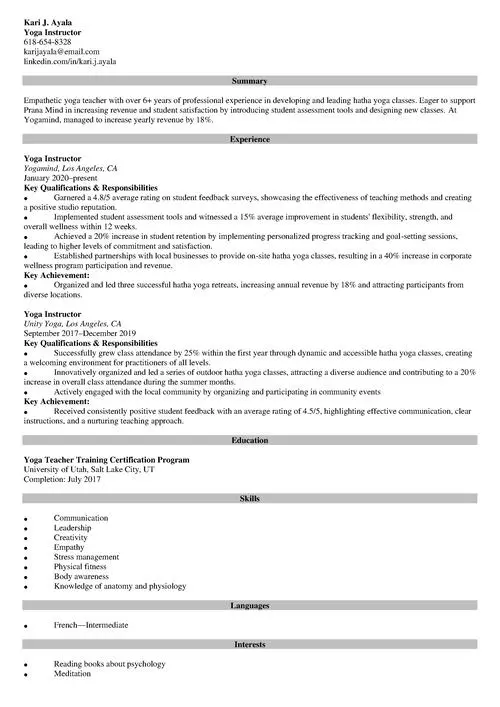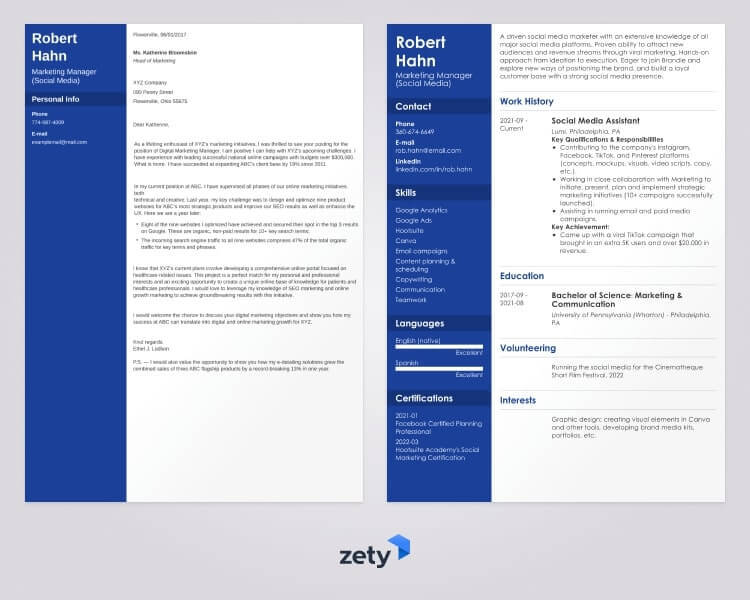Resume parsing may sound as complicated as some physical phenomenon. However, just as you don't need in-depth knowledge about photons to turn on the light, you don't need to know the ins and outs of resume parsing tools to get your resume successfully processed by them.
Let's throw some light on resume parsing and discover the best tips for optimizing your job application for resume parsing software. It's time to put your career in the spotlight!
This guide will show you:
- What is resume parsing, and how does resume parsing software work.
- Why companies use resume parsers.
- 8 tips to make your job application ready for resume parsing software.
Want to save time and have your resume ready in 5 minutes? Try our resume builder. It’s fast and easy to use. Plus, you’ll get ready-made content to add with one click. Explore our free resume templates and start building your resume today.
Sample resume made with our builder—See more resume examples here.
Curious about more resume-writing tips? Read the articles below:
- Resume Formats
- Resume Layout
- Resume Order
- Resume Outline
- Resume Elements
- Resume Styles
- Resume Structure
- Resume Tips
- Best Resume Examples & Writing Guides for All Jobs
What Is Resume Parsing?
Resume parsing is the automated process of storing, organizing, and analyzing job applications by specialized software. It aims to quickly identify candidates who best match the job description regarding specific qualifications. Resume parsers are a part of most ATS (applicant tracking software).
Read more: Best Resume Keywords [to Pass the Resume Parsing Software].
How Does Resume Parsing Work?
The process of parsing resumes begins with manual or automated upload of all the job applications. Then, the recruiter sets specific requirements for the data a resume parsing tool should extract and analyze.
This step is crucial, as the HR professional determines what they seek in an ideal candidate. They usually input requirements such as specific professional skills, desired work experience, contact information, certifications, etc.
Now the resume parsing software does its magic and gives the hiring manager a list of resumes that best fit the job vacancy. It saves a lot of time that would otherwise be wasted manually going through all the resumes. Well, if only we could use a similar tool to quickly select what to watch on Netflix…
Why Do Companies Parse Resumes?
They do it to simplify and speed up the recruitment process. Resume screening takes, on average, approximately 23 hours per job opening. By using resume parsing tools, companies can save a lot of time that recruiters can use on conducting job interviews and other activities.
This is especially important for large organizations that process enormous volumes of applications. With resume-screening tools now widely used, the majority of submissions never make it to a human reviewer.
Read more: HR Statistics: From Job Search to Job Interviews.
Which Resume Format Is Best for Parsing?
Resume parsers can extract data from resumes saved in Word and PDF formats. Always check which resume format the job ad asks you to use. If it’s not specified, go for a PDF resume, as this format ensures that the document will look exactly the same on all devices.
Read more: Best PDF Resume Templates (+ Format Tips).
8 Tips to Get Your Resume Past Resume Parsing Tools
Writing a resume ready for the resume parsing software is no rocket science. It’s the perfect example that less is more. Follow the steps below to make sure your resume will pass the automated screening with flying colors.
1. Keep Your Resume Format Clean
You may feel the temptation to go wild with your resume’s design, especially if you’re creative. However, resume parsers struggle to extract data from documents with complicated formatting. That’s why it’s better to choose a simple resume template.
2. Choose Simple Fonts
Classic, legible resume fonts are your best friends. Don’t shoot yourself in the foot by opting for fancy font styles. Keep it simple and limit yourself to just two fonts—one for headings and one for the resume body.
3. Use Traditional Resume Section Headings
Again, don’t get creative and stick to the basics. Calling your skills section “my superpowers” may sound cool, but it’s a foolproof way to confuse resume parsing tools. The only exception to that rule: you’re actually the next Clark Kent.
4. Optimize for Keywords
Tailoring your resume to the job description is not just about dazzling the recruiter. It’s also about passing the automated check done by the resume parsers. Using the exact words that appear in the job ad is one of the most important things you can do to get your resume through resume parsing tools.
5. Avoid Complex Formatting
Don’t confuse the tools parsing your resume with unnecessary elements such as headers, footers, images, charts, tables, columns, etc. These can make it impossible for resume parsers to extract and analyze the data they contain.
6. Add Your Name to Your Resume’s Filename
This one is crucial not only because of the resume parsing process. It’s also so your resume doesn’t get lost among thousands of similarly-named files.
7. Use Only Common Abbreviations
Make sure to limit the number of abbreviations that you use and only opt for the most popular ones. Otherwise, the tools used for resume parsing may not analyze your resume correctly.
8. Proofread Your Resume
Before you send your job application, double-check for any mistakes and typos. Sometimes a silly typo can cause issues during the resume parsing process. You can proofread your resume on your own or ask a friend to do it for you. A person who reads your resume for the first time is more likely to catch any imperfections.
Read more: How to Write a Resume.
Plus, a great cover letter that matches your resume will give you an advantage over other candidates. You can write it in our cover letter builder here. Here's what it may look like:
See more cover letter templates and start writing.
Key Takeaways
Now you know all the most important aspects of resume parsing. Let’s summarize the key bits of information:
- Resume parsing refers to the automated analysis of job applications by resume parsing software.
- To ensure that your resume actually gets read by the recruiter, you need to optimize it for resume parsers.
- Stick to traditional resume writing and formatting rules to get your job application through the resume parsing software.
About Zety’s Editorial Process
This article has been reviewed by our editorial team to make sure it follows Zety's editorial guidelines. We’re committed to sharing our expertise and giving you trustworthy career advice tailored to your needs. High-quality content is what brings over 40 million readers to our site every year. But we don't stop there. Our team conducts original research to understand the job market better, and we pride ourselves on being quoted by top universities and prime media outlets from around the world.



